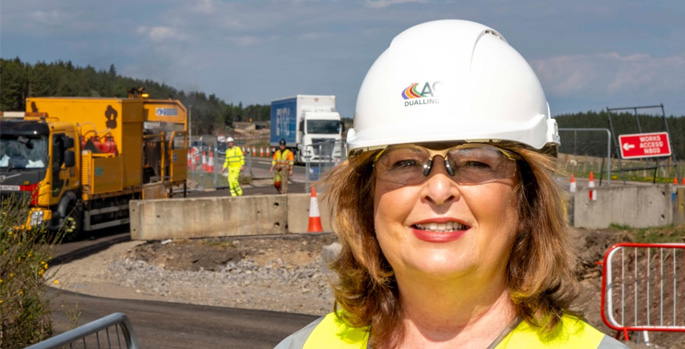Scottish transport secretary, Fiona Hyslop has overseen the launch of major construction works on the third section of the A9 Dualling programme between Tomatin and Moy.
The works to dual the A9 between Tomatin and Moy will involve moving 1,000,000 cubic meters of material, excluding topsoil – equivalent to about 400 Olympic size swimming pools – and involve 32,000 tonnes of pavement surfacing material.
Four new structures (Tomatin Junction Underpass, Dalmagarry Bridge, Moy Bridge and Lynbeg Junction underpass) will be built during construction as well as 10km of new and improved non-motorised user routes and 41 culverts.
While visiting the site, Ms Hyslop witnessed some of the work taking place to realign the Dalmagarry burn that will continue over the coming weeks.
Transport Scotland said that local communities and stakeholders have been consulted regarding the works, which included ‘ensuring that appropriate measures are being taken to protect the wildlife present including water voles’.
It added that the £185m contract – which is being carried out by Balfour Beatty – will also support social, economic and environmental outcomes for the local community as part of the A9 Dualling’s Social Value Programme.
This work also coincided with the publication of the Prior Information Notice (PIN) for the fifth section of the work between Pitlochry and Killiecrankie, alerting contractors and their supply chain of the upcoming procurement opportunity to dual the section.
Ms Hyslop said: ‘The scale of the work being undertaken on the Tomatin to Moy section is significant and it was good to see how planning has already been undertaken to address the variety of engineering challenges and to prepare the earthworks required to complete this vital project.
‘This tangible progress, alongside the publication of the PIN notice for the fifth section between Pitlochry and Killiecrankie illustrates the real momentum taking place along the A9 corridor as we move forward with our delivery plan which will see the A9 between Perth and Inverness fully dualled by 2035.’
Transport Scotland’s team leader for the project, Stuart Baird, said: ‘We are pleased to see construction beginning in earnest, and we are working closely with our contractors, Balfour Beatty to minimise disruption to road users as far as possible. I want to thank road users and the local community and businesses for their patience whilst these vital works are undertaken.’






